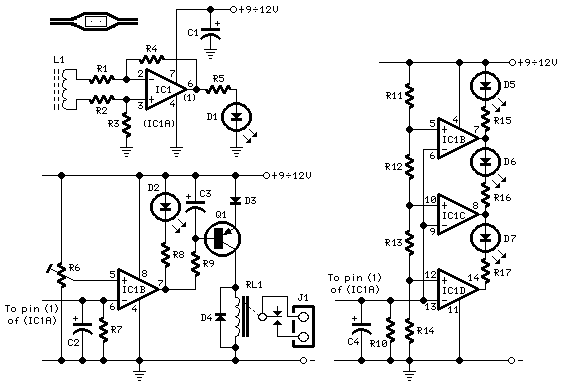AC Current Monitor
Senses high current-flow into power cables
No wire-cutting, three versions available
Parts:R1,R2,R8____________1K 1/4W Resistors R3,R4_____________220K 1/4W Resistors R5________________100R 1/4W Resistor (See Notes) R6_________________10K 1/2W Trimmer Cermet R7,R10______________1M 1/4W Resistors R9_________________22K 1/2W Resistor R11 to R17__________1K 1/4W Resistors C1,C3_____________100µF 25V Electrolytic Capacitors C2,C4_______________1µF 63V Electrolytic Capacitors D1________________5mm. Red LED D3,D4___________1N4002 100V 1A Diodes D2,D5,D6,D7_______LEDs (Any color and size) Q1_______________BC327 45V 800mA PNP Transistor IC1______________TL061 Low current BIFET Op-Amp (First version) IC1______________LM358 Low Power Dual Op-amp (Second version) IC1______________LM324 Low Power Quad Op-amp (Third version) L1________________10mH miniature Inductor (See Notes) RL1______________Relay with SPDT 2A @ 220V switch Coil Voltage 12V. Coil resistance 200-300 Ohm J1_______________Two ways output socket
Device purpose:This circuit was designed on request, to remotely monitor when a couple of electric heaters have been left on. Its sensor must be placed in contact with the feeder to be able to monitor when the power cable is drawing current, thus causing the circuit to switch-on a LED.
The circuit and its sensor coil can be placed very far from the actual load, provided an easy access to the power cable is available.
Any type of high-current load or group of loads can be monitored, e.g. heaters, motors, washing machines, dish-washers, electric ovens etc., provided they dissipate a power comprised at least in the 0.5 - 1KW range.
This design features three versions. The basic one illuminates a LED when the load is on. The second version drives a Relay when a pre-set current value flows into the power cable. The third version switches-on D7 when the load power is about 1KW, D6 when the load power is about 2KW and D5 when the load power is about 3KW.Circuit operation:
The basic circuit is shown top left in the drawing and must be used in all three versions. IC1 acts as a differential amplifier having a gain of 220. The small AC voltage picked-up by L1 is therefore amplified to a value capable of driving the LED D1.
The second version is drawn bottom left, must be connected to the basic circuit and uses a dual op-amp, therefore IC1 will be labeled IC1A and its pin connection varies slightly. IC1B acts as a voltage comparator and its threshold voltage can be precisely set by means of trimmer R6. Q1 is the Relay driver and D2 illuminates when the Relay is on. You can use the Relay contacts to drive an alarm or a lamp when the AC load exceeds a pre-set value, e.g. 2KW.
The third version is shown to the right of the drawing, must be connected to the basic circuit and uses a quad op-amp, therefore IC1 will be labeled IC1A and its pin connection varies slightly. IC1B, C and D are wired as comparators. They switch on and off the LEDs, referring to voltages at their non-inverting inputs set by the voltage divider resistor chain R11-R14.Notes:
The pick-up coil L1 is a common 10mH miniature inductor, having the shape of a small rectangular plastic box of 10x7x4 mm. with radial leads.
This inductor must be placed tightly against one wire of the power cable, leaving the other wire some centimeters apart.
The sensitivity will be doubled if the inductor is placed tightly between the two wires as shown in the diagram, top left. On the contrary, do not place the inductor against paired wires as the signal tends to cancel and the circuit will not work.
The LED limiting resistor R5 should have a value comprised in the 100R - 1K range, depending on the output voltage obtained.
LED D1 and its limiting resistor R5 can be omitted in versions two and three of the circuit.
Versions one and three draw a small current, thus allowing possible 9V battery operation.







